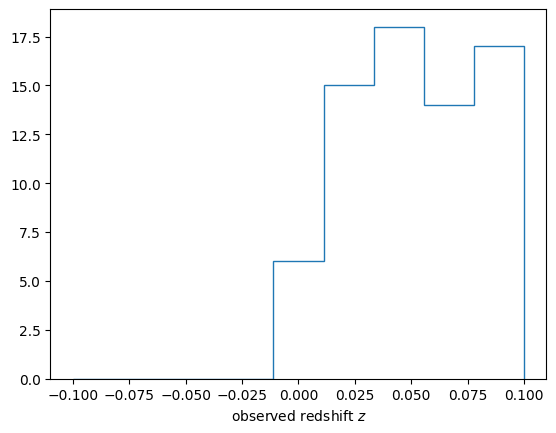4D Simulation
The following is a simple 4D simulation where cosmic rays are emitted by a source at a specified spatial position at a specified time-point. A cosmic ray is detected if it arrives at the observer position within a specified time window.
Note: In CRPropa, time is always expressed in terms of redshift \(z\), whereas positions are always expressed in terms of comoving coordinates as Cartesian 3-vectors.
Simulation setup
The simulation setup is that of a 3D simulation with a few additions: 1. We add a source property for the redshift at emission. This can be either SourceRedshift, SourceUniformRedshift or SourceRedshiftEvolution. 2. The simulation module FutureRedshift implements adiabatic energy loss and updates the redshift. In contrast to Redshift it allows particles to be propagated into the future \(z < 0\) which enables faster convergence for finite observation windows. 3. The
observer feature ObserverRedshiftWindow specifies a time window \(z_\mathrm{min} < z < z_\mathrm{max}\) in which particles are detected if they hit the observer. Note that this can also be done after the simulation by cutting on the redshifts at observation. For this we also output the current redshift at observation. 4. A minimum redshift is defined via MinimumRedshift which we set to the lower bound of the observer time window.
Periodic boundaries
Due to the additional time dimension, particles are detected much less often. In order to increase the otherwhise horrible simulation efficiency, a PeriodicBox is defined: Particles that leave this simulation volume, enter again from the opposite side and their source position is moved accordingly. As a result the periodic boundaries keep the particles close to the observer and therefore increase the chance of detection. A careful setup is required however: 1. Sources should only be defined
inside the volume as sources outside are filled up by the periodic conditions. 2. The magnetic field at the boundaries should be periodic as well. This is the case for initTurbulence as long as the simulation volume coincides with (multiples of) the magnetic field grid.
Source positions
In the example below, a single source is defined. For specifying multiple identical discrete sources SourceMultiplePositions can be used. Multiple non-identical sources can be added to a SourceList. For continous source distributions SourceUniformSphere, SourceUniformBox and SourceUniformCylinder can be used. SourceDensityGrid allows to specify a source distribution via a 3D grid.
Note:
This simulation may take several minutes.
[1]:
from crpropa import *
# set up random turbulent field
Brms = 1 * nG
lMin = 60 * kpc
lMax = 800 * kpc
sIndex = 5./3.
turbSpectrum = SimpleTurbulenceSpectrum(Brms, lMin, lMax, sIndex)
gridprops = GridProperties(Vector3d(0), 256, 30 * kpc)
Bfield = SimpleGridTurbulence(turbSpectrum, gridprops, 42)
# simulation setup
sim = ModuleList()
sim.add(PropagationCK(Bfield))
sim.add(FutureRedshift())
#sim.add(FutureRedshift()) # Switch back to FutureRedshift when PR #416 is merged
sim.add(Redshift())
sim.add(PhotoPionProduction(CMB()))
sim.add(PhotoPionProduction(IRB_Kneiske04()))
sim.add(PhotoDisintegration(CMB()))
sim.add(PhotoDisintegration(IRB_Kneiske04()))
sim.add(ElectronPairProduction(CMB()))
sim.add(ElectronPairProduction(IRB_Kneiske04()))
sim.add(NuclearDecay())
sim.add(MinimumEnergy(1 * EeV))
#sim.add(MinimumRedshift(-0.1)) # Switch back to z_min=-0.1 when PR #416 is merged
sim.add(MinimumRedshift(0.))
# periodic boundaries
extent = 256 * 30 * kpc # size of the magnetic field grid
sim.add(PeriodicBox(Vector3d(-extent), Vector3d(2 * extent)))
# define the observer
obs = Observer()
obs.add(ObserverSurface( Sphere(Vector3d(0.), 0.5 * Mpc)))
obs.add(ObserverRedshiftWindow(-0.1, 0.1))
output = TextOutput('output.txt', Output.Event3D)
output.enable(output.RedshiftColumn)
obs.onDetection(output)
sim.add(obs)
# define the source(s)
source = Source()
source.add(SourcePosition(Vector3d(10, 0, 0) * Mpc))
source.add(SourceIsotropicEmission())
source.add(SourceParticleType(nucleusId(1, 1)))
source.add(SourcePowerLawSpectrum(1 * EeV, 200 * EeV, -1))
source.add(SourceRedshiftEvolution(1.5, 0.001, 3))
# run simulation
sim.setShowProgress(True)
sim.run(source, 10000)
output.close()
crpropa::ModuleList: Number of Threads: 16
Run ModuleList
Started Tue Jan 9 10:49:16 2024 : [ Finished ] 100% Needed: 00:00:34 - Finished at Tue Jan 9 10:49:50 2024
[2]:
columnnames=['D', 'z', 'ID', 'E', 'X', 'Y', 'Z', 'Px', 'Py', 'Pz','ID0', 'E0', 'X0', 'Y0', 'Z0', 'P0x', 'P0y', 'P0z']
types = [float] * len(columnnames)
import numpy as np
data = np.loadtxt('./output.txt', dtype={'names': columnnames, 'formats': types})
[3]:
import matplotlib.pyplot as plt
bins = np.linspace(-0.1,0.1, 10)
plt.hist(data['z'], bins=bins, histtype='step')
plt.xlabel(r'observed redshift $z$')
plt.show()

[ ]: